Content marketing is the new way big brands are built.
As an ad agency owner, I’ve partnered with countless companies, navigating the maze of content creation and best practices. Through trial, error, and endless cups of coffee, I’ve observed what works and what doesn’t.
In this guide, I want to share a comprehensive collection of proven content marketing best practices that truly grow your audience. If you’re a business owner or founder looking to tap into the power of content, you’ve come to the right place.
Let’s identify together what result-driven content marketing best practices look like.
11 Tested Content Marketing Best Practices [2023]
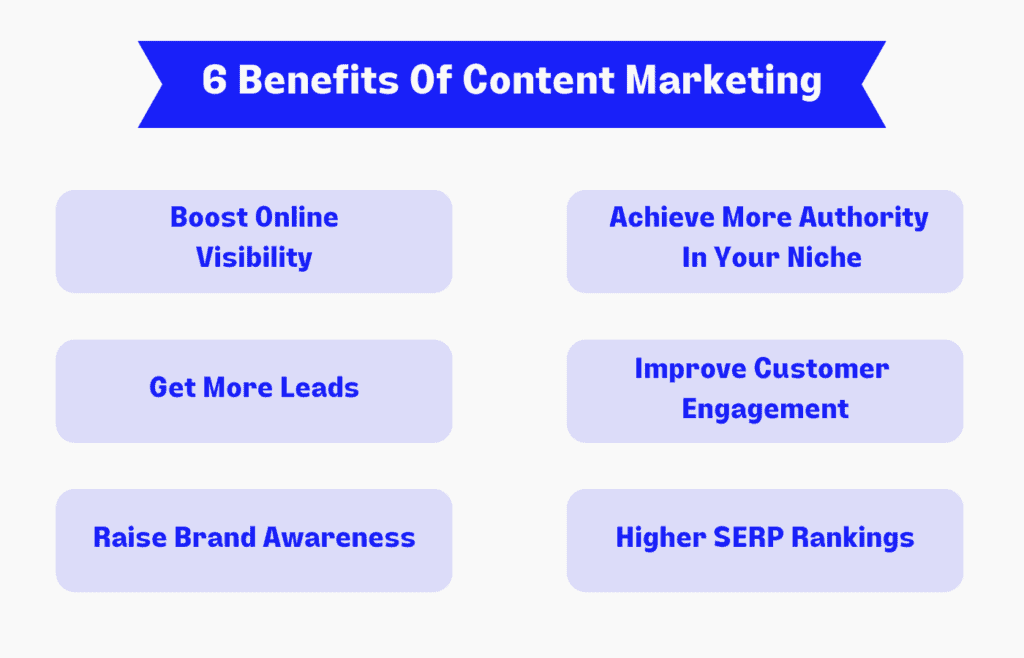
Technical SEO is not the only factor you should think about when working to rank high in SERPs. What your target market reads, sees, and even watches from your brand also plays a dominant role.
Through this list of content marketing best practices, we won’t simply tell you what these practices are. We’ll teach you what this best practice is, why it’s important, and how you can implement it. Pay close attention to actionable points and tools you need to be familiar with to develop a successful content marketing strategy.
1. Identify Your Audience
This means determining and understanding who you’re speaking to and what they truly need. While it’s tempting to showcase your products or services, remember that they’re more concerned about you addressing their pressing needs.
Why is this important?
Because pinpointing your target audience lets you tailor your content marketing efforts to their specific desires and challenges. Knowing this, you can create relevant content that resonates, rather than just adding online noise.
This can also build genuine engagement since your efforts to help will come across.
To do this, you need to build buyer personas and leverage data.
A buyer persona is your ideal customer’s detailed profile. To craft these personas, dive into their demographics, interests, challenges, and behaviors. The more detailed, the better.
You can get that information through market research, interviews, and surveys. You can use the following tools:
- Skype, Zoom, and Google Hangouts to conduct interviews.
- Survey Monkey, Google Forms, and Typeform to create surveys.
- Google Analytics and Hotjar to monitor user behavior on your website.
- Make My Persona and Semrush Persona to get templates for your buyer persona visualization.
Once you’ve gathered this information, mold it into distinct personas representing different segments of your audience.

To leverage data in identifying and understanding your audience, analyze metrics from your blog post interactions like clicks, shares, and comments.
For example, if a post about “Latest SEO Techniques” receives significantly higher engagement compared to an article on “Email Marketing Trends,” it suggests a segment of your audience has a greater interest in SEO over email marketing within your digital marketing audience.
Integrating these buyer personas and data into your content marketing strategy and content creation process guarantees that your content strategy is on point. Instead of shooting in the dark, you’re creating relevant content tailored to your audience’s specific needs and pain points.
2. Set Clear Objectives
This means pinpointing your content strategy goals. Do you aim to drive traffic or prioritize boosting conversions? Do you want to engage readers or just inform them?
Defining these goals makes your content creation purpose-driven and guides you in deciding which content formats are in line with your objectives.
If your goal is engagement, you might craft interactive blog posts that include a chatbot, quizzes, GIFs, and social share buttons. But if you’re focused on informing, long-form high-quality content might be your go-to.
But how do you do this in content marketing?
Understanding the funnel stages: ToFu, MoFu, and BoFu set precise marketing goals.
- Top of the Funnel (ToFu): The objective is to build awareness and generate interest. At this stage, potential customers are just becoming aware of their problem or need, but they might not know your brand or solution yet. These are mostly “what is” topics.
- Middle of the Funnel (MoFu): Potential customers at this stage are actively researching potential solutions, including yours. These are mostly the “benefits”, “challenges”, etc article types. Your content should offer valuable information and resources that help potential customers evaluate their options and consider your solution as a strong contender.
- Bottom of the Funnel (BoFu): This is the decision and conversion stage. These are usually the “XX Best” or “how to” articles since they give your prospects one more push to decide since they highlight how your products or services can help them.

So, if you know which part of the funnel your target audience is at, you can set goals and create content relevant to where they are in their buyer’s journey.
3. Audit Existing Content
This involves evaluating what you’ve already published to determine whether it’s still relevant and effective. Think of it as spring cleaning for your digital space.
Doing a content audit helps you identify pieces that can be refreshed to align with current trends or search engine preferences. It also identifies outdated or low-performing content that might be better off deleted.
For instance, an old blog post about mobile internet might be updated with new data showing an increase in mobile shopping. This lets you repurpose content and make sure content quality stays high and accurate. In doing this, you maintain an effective strategy that keeps your brand current and authoritative in your audience and search engine eyes.
Leverage Google Analytics to dive into metrics like page views, bounce rates, and time spent to gauge your web pages’ performance.
Pages with low engagement might need a refresh or even removal. For evergreen content that consistently performs well, consider updates to maintain its authoritative content status.
Moreover, stay abreast with industry trends and search engine algorithms. You should engage in webinars, subscribe to industry newsletters, and join relevant forums.
4. Analyze Search Terms & Research Topics In-Depth
When creating content, it’s not just about what you want to say, but what your audience wants to hear. Focusing on target search terms lets you create content that aligns with their queries, making it more discoverable and engaging.
But more than incorporating search terms, in-depth content is vital. You can conduct original research to gather fresh statistics or interview industry leaders for trusted and unique insights.
How do you achieve this?
4.1. Search Term Deconstruction
This is another way of saying to do search term research. Look at competitor sites and research related topics using Ahrefs and Google Search. You can also use Google Ads Keyword Planner to discover new search terms or get search volume and forecasts.
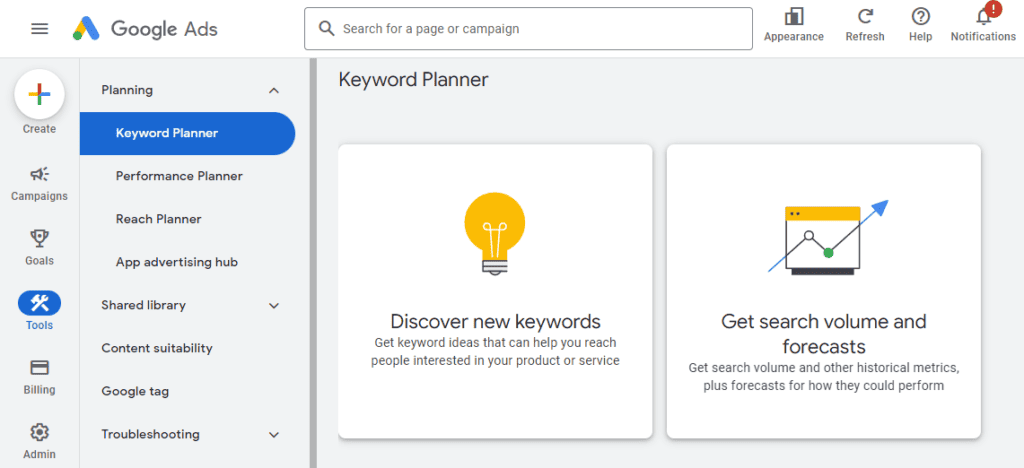
This step helps you identify the hubs. After identifying the hubs, you can go further down the line and check if those hubs are big enough to have sub-hubs that are relevant to your company.
You can identify these topics’ hierarchy and then base the topical map from there. This means categorizing and grouping related search terms based on their topics or themes. This helps you see the bigger picture and the relationships between different terms.
4.2. Identify Content Gaps
Using SEMrush and Moz, you can compare your site against competitors in organic search. They highlight search terms they rank for, which you still don’t.
Diving into these insights lets you discover potential topics or angles to explore. Addressing these content gaps ensures you’re not just keeping pace but potentially outshining competitors.
4.3. Google Features
Here are the Google features you can use in creating content:
- Auto-fill: It predicts user queries, offering insights into popular searches.
- People also ask: It showcases related questions, helping you address broader audience concerns.
- Featured snippets: This highlights the top-ranking content’s structure, guiding you in creating content with a winning format.
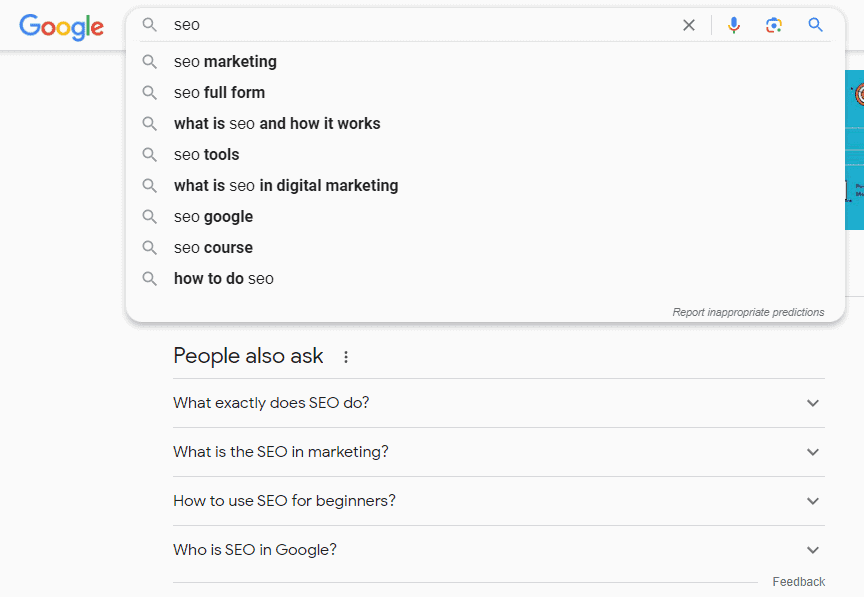
4.4. Create Evergreen Content
Evergreen content remains relevant long after its initial publication, driving continuous customer engagement. To craft this content, focus on timeless topics that aren’t tied to fleeting industry trends.
During content production, prioritize quality, depth, and comprehensive insights. Be accurate and avoid time-sensitive references. Investing in evergreen pieces helps you build a foundation that keeps attracting and educating audiences, maximizing your content’s lifespan and impact.
5. Build Topical Authority
In content marketing, topical authority is the expertise and credibility your website holds on a specific subject in the eyes of users and search engines.
Why is this crucial?
When your content is recognized as a go-to source for specific topics, it makes your site more visible and trustworthy. Search engines, seeing you as a trusted expert, will rank your content higher. Readers, recognizing your expertise, are more likely to engage and share your content.
To achieve a coveted status in your niche, leverage the hub and spoke method. The hub is the central piece, a comprehensive guide or pillar content on a broad topic.
The spokes are smaller, related articles that delve into the topic’s specific aspects. Together, they create a cohesive content ecosystem.
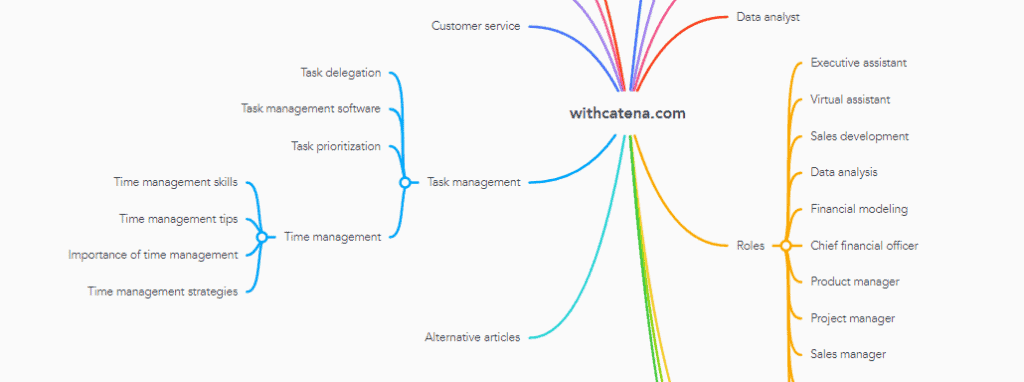
Here’s an example topic: Digital Marketing.
Your hub could be a detailed guide on “Digital Marketing Strategies for 2023.” Spokes branching from this hub might include topics like “The Importance of Link-Building,” “Advanced Email Marketing Techniques,” and “SEO Software For Small Businesses.”
Interlinking the hub with these spokes provides your readers with a deep dive into your topic and signals to search engines your comprehensive coverage of the topic. This positions your website as an authoritative source.
6. Identify Search Intent
Search intent dives into the “why” behind a user’s search query. It’s the purpose driving a user to type a specific phrase or question into a search engine.
Is the user looking to buy, learn, or compare?
In the content marketing world, understanding search intent is like having a compass. It checks if your content marketing strategy aligns with what users genuinely seek. If your published content matches their intent, it’s more likely to rank higher.
How do you achieve this? Analyze the search engine results pages (SERPs).
Look at the top results for your target search terms. Are they informational blog posts, product pages, or user-generated content? This gives you a hint about the prevailing search intent.
If you search for “best hiking boots,” and the top results are buying guides or product reviews, the intent is transactional. On the other hand, a query like “How to care for hiking boots” might yield instructional blog posts, indicating an informational intent.
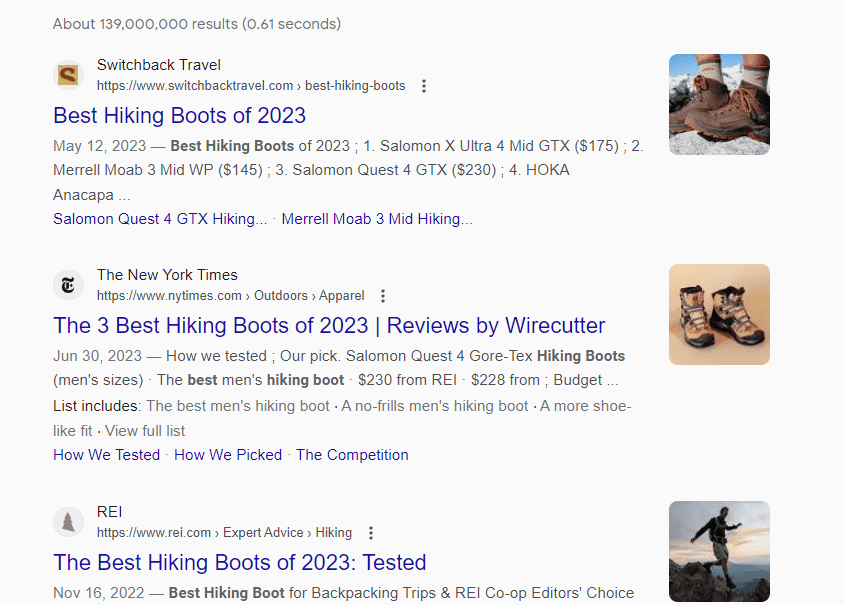
However, don’t stop at external content. Look into feedback from your existing customers. Their questions and concerns can offer insights into search intent, helping you craft content that hits the mark.
When you align your content with your audience’s search intent, you’re answering their question, solving their problems, and meeting their needs.
7. Leverage AI
AI is all the rage in the digital world and its influence on content marketing trends is undeniable.
But why is artificial intelligence so popular?
It streamlines processes, offers insights, and enhances user experience, making content marketing more efficient and effective.
Here are a few ways AI-powered tools help with your content creation:
- ChatGPT: Generates descriptions, explanations, summaries, and more, aiding in content creation. If you need a quick blog draft or ideas; ChatGPT can whip up engaging content in no time.
- SurferSEO: Analyzes top-ranking pages, offering real-time recommendations to optimize your content for better search visibility through its “Content Editor” feature.
- Grammarly: Beyond basic grammar checks, Grammarly uses AI to enhance content readability, tone, and clarity, making sure your message is not only error-free but also resonates with your audience.
- AI Checker: These tools can scan content, predicting how much of the content is human-written, this allows you to humanize content before publication.
Let’s say you’re launching a new product. You draft a blog post using AI, and Grammarly helps refine its tone. SurferSEO offers optimization practices based on competitors. Before publishing, an AI checker helps you check if it’s “human” enough, meaning no intricate sentences or highly technical jargon.
However, don’t over-rely on AI. Writing, editing, proofreading, and even publishing should be left to humans to resonate with your fellow human audience better.
8. Make Content Dynamic & Digestible
Did you know that 91% of smartphone users look up information on their phones while in the middle of a task? Nowadays, online users look for quick information or micro-moments. They crave immediate answers to what they’re searching for.
So crafting engaging, easily consumable pieces captivates your readers and keeps them hooked.
In online content’s vast sea, static and boring just won’t cut it. Your content marketing team needs to ensure that when publishing content, it stands out and resonates.
How can you achieve this?
| Visual Content Type | How It Helps |
| Video Content | Embed a YouTube video to explain concepts better, making information more engaging. |
| Infographics | This shareable visual offers concise information, providing readers with a quick overview of a topic. |
| Statistics | Numbers lend credibility and adding relevant statistics throughout your content bolsters your claims and engages readers with tangible facts. |
Use free tools like Canva to create infographics and Google Images to find valuable, relevant images.
But it doesn’t end there.
Here are other ways to create engaging content:
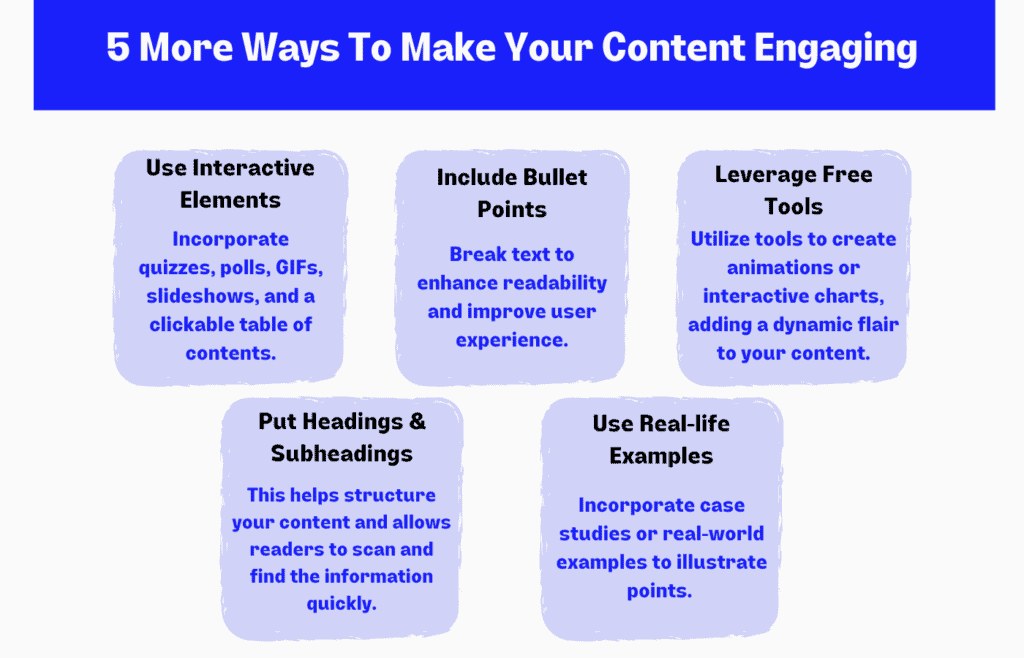
For example, let’s say you’re writing about the plant-based diet benefits. Instead of a long, text-heavy article, you could:
- Cite statistics on health improvements.
- Use an infographic to highlight the environmental benefits.
- Embed a YouTube video showcasing a day in the life of a vegan.
9. Linking Deep
Internal linking refers to linking to more in-depth, often older or less visible pages on your website from newer or high-traffic pages.
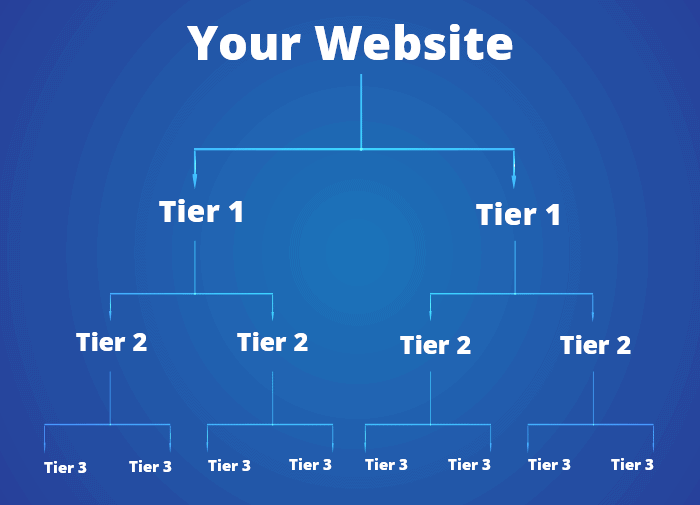
Why is this important?
This guides visitors deeper into your site, increasing page views. It also plays a pivotal role in distributing content evenly across your site. Linking deep makes sure that even older content, which might be some of the best content marketing examples you have, gets the attention it deserves.
This helps retain visitors and signals search engines about your content’s relevance and structure.
How do you do this? Divide your topics or content into 3 tiers.
- Tier 1 topics are the big hubs, they are the main topics (e.g. Lead Generation).
- Tier 2 topics are usually subtopics of the main topic (e.g. Methods of Lead Generation and Lead Generation Strategies).
- Tier 3 topics are mostly low volume/long tail search terms that cover the topics more holistically (e.g. Social media platforms for effective lead generation).
Using the tier system, it’s easier to identify which blog post to link to another.
10. Set Baselines & Track KPIs
Baselines in content marketing represent your starting point, the initial metrics before implementing changes or new strategies. Key Performance Indicators are the measurable values that show how effectively you’re achieving your marketing objectives.
Here’s an example: Say you’re a content marketer aiming to publish original research.
Your baseline might be the current traffic to your existing content. After publishing, you’d track KPIs like site visits, shares, or backlinks to gauge your research’s impact.
Why are these important?
Setting baselines and tracking KPIs provide clarity on where your website stands. Plus, they also offer tangible proof of whether your marketing strategy is working. Without these metrics, you and your content marketers are essentially navigating without a map.
To do this, know how your search terms would fit into your content so you can build appropriate KPIs or baselines. Let’s say you’re looking for relevant ideas to the search term “food waste.”
- “Food waste solutions” (KD:65, Search Volume:600): User intent for this is likely informational since they’re looking for sustainable alternatives. Your content should focus on practical advice, how-to guides, or product recommendations for minimizing food waste. KPIs to track could include page views, time spent on a page, and social shares.
- “Food waste apps” (KD:25, Search Volume:500): The intent here is highly transactional. Users are looking for specific applications to help manage or reduce food waste. You can create content that includes app reviews, tutorials, feature comparisons, or best food waste app lists. KPIs to monitor would be click-through rates (especially for app download links), page views, user comments, or inquiries about your specific app.
As you can see, despite being relevant terms, the intent for those search terms are different. So, the content you produce and the KPIs you monitor would be different.
11. Establish Publishing Cadence
This refers to setting a consistent schedule for releasing your content. Think of it as the heartbeat of your content marketing, dictating when and how often you push content through organic channels.
Why is this rhythm vital in content marketing?
A regular content calendar keeps your audience engaged and returning for more. They’ll know when to expect fresh content, building anticipation. Plus, Google says that the content’s freshness plays a big role when answering queries about current events.
Use an editorial calendar to maintain this cadence. It’ll act as a roadmap, guiding what content gets published and when.
But remember, consistency isn’t just about frequency; it’s about building trust, staying top-of-mind, and ensuring your content drives the most traffic possible.
Here’s a guide to creating your content marketing program timeline:
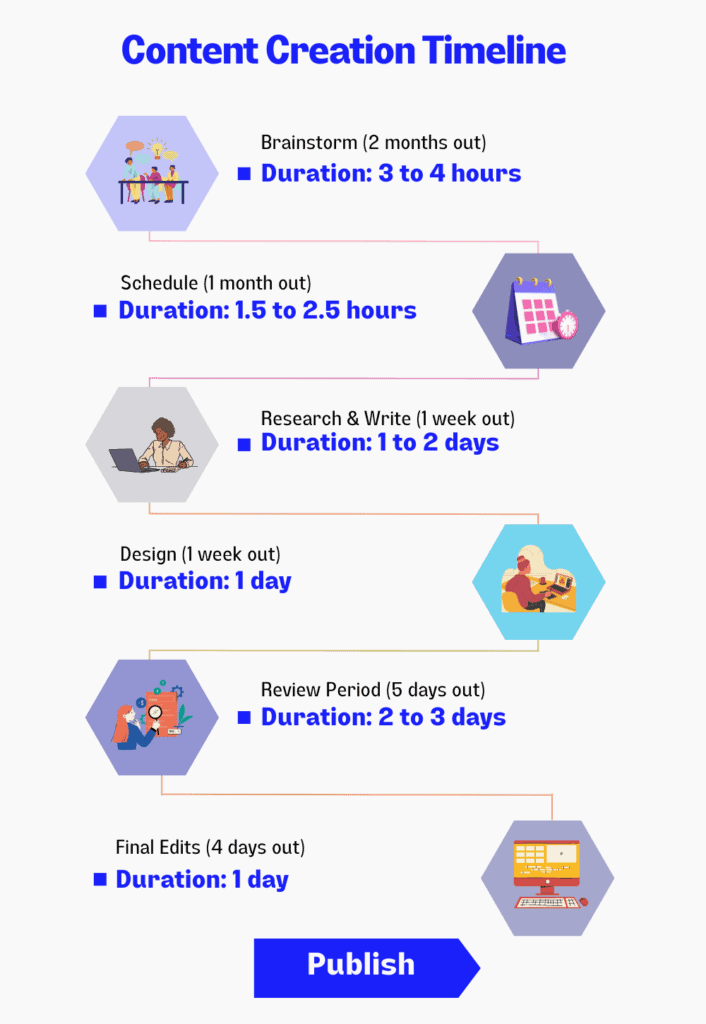
Remember that in content marketing, you need to prioritize quality over quantity. It’s better to have 4 to 5 solid, in-depth, and well-researched pieces rather than publishing thin pieces that don’t provide much value 1x daily.
How do you decide which topics go into the content calendar?
Base it on the topic you’re prioritizing. You should also mix in low KD (0 to 10) long-tail search terms and high KD (70%) competitive search terms so you can have ranking signals and also make sure you have topical authority.
The Best Practice You Can Do Now
Content marketing is ever-evolving and adhering to content marketing best practices is not just a recommendation. It’s an absolute necessity for your overall marketing strategy to succeed.
But as you navigate the myriad of best practices and tactics, you’ll see 1 truth that remains clear: Every content should serve a purpose and meet your user’s intent.
It’s not just about producing content; it’s about creating the right content for the right audience. The most effective practices are those that prioritize the needs and interests of your audience.
How can you consistently deliver value and turn your content marketing strategy into continuous streams of customers?
Partnering with Novum is one way. With experts in the SEO and content marketing fields, Novum can help you turn your content into channels that drive traffic, leads, and conversions. Remember Aloa and Estuary? You can experience the same results as they did.
If you’re still unsure, get your free consultation now and start building your content strategy!

